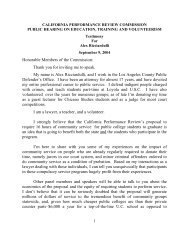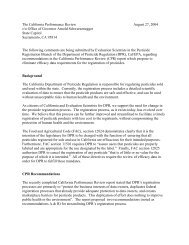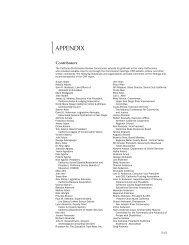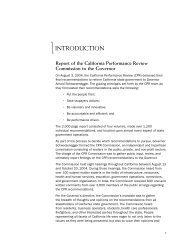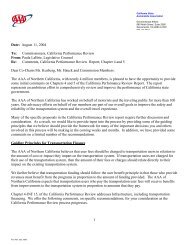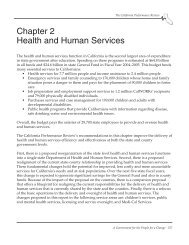August 13, 2004 - The California Performance Review
August 13, 2004 - The California Performance Review
August 13, 2004 - The California Performance Review
You also want an ePaper? Increase the reach of your titles
YUMPU automatically turns print PDFs into web optimized ePapers that Google loves.
<strong>August</strong> <strong>13</strong>, <strong>2004</strong><br />
COMMENTS ON THE CALIFORNIA PERFORMANCE REVIEW<br />
AUTOMOBILE CLUB OF SOUTHERN CALIFORNIA<br />
<strong>The</strong> Automobile Club of Southern <strong>California</strong> (Auto Club) appreciates the opportunity to<br />
make initial comments on a number of the infrastructure-related recommendations<br />
offered in the <strong>California</strong> <strong>Performance</strong> <strong>Review</strong> (CPR). <strong>The</strong> Auto Club applauds the effort<br />
and expertise that went into crafting the CPR and believes that many of its goals and<br />
recommendations will improve <strong>California</strong> governance, decision-making and project<br />
delivery.<br />
<strong>The</strong> Auto Club is a nonprofit motor club that has been providing services to members<br />
since 1900. Some of those early services included providing signage for newly<br />
developed roads and assisting in the creation of our transportation network. Mobility for<br />
our members has been a priority since our founding, and the ability to move about the<br />
state – and the adverse impact our worsening congestion has on our ability to do so<br />
easily – remains a significant concern for our over 5.5 million Southern <strong>California</strong><br />
members.<br />
While we recognize the diversity of interests and views represented by these<br />
recommendations, we note that motorists – those who pay for and use our<br />
transportation system (and the other components of the state’s infrastructure as well) –<br />
have not had significant input into the report. Many of the recommendations have the<br />
potential to affect our members’ daily lives because congestion is a reality that most of<br />
us live with every day. Auto Club members are by far the largest group of individuals<br />
who both use and pay for our transportation systems. <strong>The</strong>y need, expect, and deserve<br />
improved transportation services and better transportation alternatives and have strong<br />
feelings about how this can be accomplished.<br />
Following are our preliminary thoughts about some of the recommendations in the CPR<br />
most likely to affect our members. In addition, we have provided suggestions on topics<br />
not included in the CPR but which we believe would complement and enhance this<br />
effort.<br />
A. Comments on Transportation-Related Recommendations<br />
Creation of a Comprehensive Infrastructure Agency (Page 690 and Chapter 7)<br />
We agree that taking a comprehensive approach to the state’s infrastructure needs and<br />
challenges will help avoid some of the disjointed and disconnected planning that goes<br />
on today. Decisions regarding housing, roads, water and other necessities, if made<br />
independently, can result in a less efficient and effective use of scarce and often<br />
expensive resources. However, care must be taken to assure that the various<br />
infrastructure needs do not find themselves in competition for funding. <strong>The</strong> state
constitution provides dedicated funding (primarily through the state motor vehicle fuel<br />
excise tax) for certain transportation purposes. However, during recent years, that<br />
funding source has been diverted to other uses. We are concerned that combining<br />
transportation within an Infrastructure Agency could result in similar diversion and may<br />
lessen focus on critical transportation issues. This does not have to, and must not be<br />
allowed to, happen.<br />
INF01 - Project Delivery (page 695)<br />
We support the recommendation to permit the use of a variety of innovative contracting<br />
models to reduce costs and shorten project delivery times. <strong>The</strong> narrative acknowledges<br />
the problems resulting from non-compete clauses included in the AB 680 projects –<br />
specifically related to SR 91 – but the recommendation should be expanded to not only<br />
require functional definitions of non-compete clauses but also to require that publicprivate<br />
franchises not preclude public construction necessary to protect public safety.<br />
<strong>The</strong> safety of our transportation system must never be subordinate to private gain.<br />
INF02 – <strong>Performance</strong> and Warranty Specifications (page 701)<br />
We support these recommendations.<br />
INF03 – Reducing the Cost of Construction Contracts (page 707)<br />
We support these recommendations.<br />
INF04 – <strong>Performance</strong> Measures in Traffic Operations (page 7<strong>13</strong>)<br />
Generally, we support these recommendations. However, the effect on other highpriority<br />
projects of increasing priority for TMS projects (Recommendation B) should be<br />
evaluated.<br />
INF05 – High-Occupancy/Toll Facilities (page 791)<br />
While in principle we agree that “HOT lanes” should be examined as a means to<br />
increase real and effective highway capacity, we are concerned with some of the<br />
content of this section. For example, the statement “In HOV lanes where ample space<br />
is available and travel time can be reduced, HOT lanes can provide an alternative<br />
source of revenue…” assumes that there is HOV space available (which in most of<br />
Southern <strong>California</strong> is not the case) and that the primary purpose of HOT lanes is to<br />
raise revenue (which should not be the case.)<br />
<strong>The</strong> report asserts that adding an HOT lane may offer more benefits than adding either<br />
a HOT lanes or a general-purpose lane, and that a new freeway can be built with fewer<br />
lanes when HOT lanes are included. <strong>The</strong>se statements are not documented. Also, the<br />
discussion focuses on HOT lanes and not on traditional toll lanes or roads, which should<br />
also be considered in appropriate circumstances.<br />
2
We appreciate that the recommendations take a cautious, deliberate and case-by-case<br />
approach to HOT lanes. We would like to offer the following principles for inclusion in<br />
discussions of tolling and HOT lanes:<br />
• Existing general-purpose highway facilities and lanes should not be tolled.<br />
<strong>The</strong> public has, in effect, already paid for them through fuel excise and other<br />
taxes and has established an expectation of use without direct payment.<br />
Public opposition to tolling existing capacity may adversely affect the<br />
prospects of tolling new capacity.<br />
• <strong>The</strong>re should be reasonable free alternatives to tolled facilities.<br />
• As a general principle, to better protect the public interest, tolled facilities<br />
should be publicly owned and operated.<br />
• If toll facilities are privately owned and operated, they must ensure that the<br />
public interest is protected, including assuring that critical safety and capacity<br />
improvements can always be made.<br />
• Variable pricing should not be set to levels that have the effect of “pricing out”<br />
the less economically advantaged, nor to coercive levels intended to forcibly<br />
modify traveler behavior.<br />
• Each proposal must take into account and propose effective mitigation for<br />
adverse effects, such as the diversion of traffic onto secondary routes to avoid<br />
tolls.<br />
• Each proposal must be fully and separately evaluated on its own merits. We<br />
strongly recommend that each proposal be approved by the Legislature. Only<br />
a few carefully selected pilot projects should proceed at this time, with<br />
evaluation providing insights into whether the public approves of road pricing.<br />
INF06 – High <strong>Performance</strong> Building Design (page 725)<br />
<strong>The</strong> recommendation in this section for life-cycle costing for state buildings should be<br />
applied to transportation infrastructure as well.<br />
INF11 – Tapping Surplus Property Assets (page 757)<br />
We generally support this recommendation. However, we urge caution in identification<br />
and disposition of property acquired for transportation projects to assure that it will not<br />
be needed for any transportation use in future. Unlike some other infrastructure, the<br />
linear and extensive right of way needs for transportation corridors make it extremely<br />
difficult to acquire property and once disposed of, it cannot be required without<br />
enormous expense, effort and time. Also, all proceeds of sale of properties acquired<br />
with State Highway Account funds should be returned to the State Highway Account.<br />
INF12 – Extra Enforcement in Highway Work Zones<br />
We believe that enhanced enforcement by the <strong>California</strong> Highway Patrol and other<br />
agencies is needed on all roadways, not just in construction and maintenance areas.<br />
<strong>The</strong> narrative makes no particular case for concentrating on these areas. We question<br />
whether stationing a uniformed CHP officer at every construction site is a reasonable<br />
use of a limited resource. More officers patrolling the highways would seem to offer<br />
3
greater protection to a broader number of people, including highway workers. We also<br />
recommend that the CHP’s role in congestion relief (by rapidly clearing incidents) be<br />
incorporated into the report.<br />
Automated enforcement is no substitute for enhanced policing to deter violations and is<br />
of no use in congestion relief. Finally, we strongly caution against waiving established<br />
and reliable requirements for engineering and traffic speed surveys in construction and<br />
maintenance areas (or anywhere else), without creating adequate safeguards to protect<br />
motorists from the imposition of "speed traps" that set unjustifiably low speeds and<br />
generate revenue by fining motorists caught in the "trap." Existing law has protected<br />
both public safety and motorists’ interests and deterred speed traps effectively for many<br />
years. We recognize that there may be good reason to reduce speeds in active<br />
construction or maintenance zones and if existing law does not include adequate<br />
provision to do so, amendments may be appropriate. However, any change in the law<br />
must assure the establishment of reasonable parameters as to location of the zone,<br />
time of day and duration of the reduced speed, and a basis for determining what a<br />
reasonable speed would be under the prevailing circumstances.<br />
INF<strong>13</strong> – State Highway Route Relinquishment (page 781)<br />
State Highway Account savings of $108 million per year are projected. <strong>The</strong>se costs<br />
would necessarily be imposed on local agencies. <strong>The</strong>re is no discussion of how local<br />
agencies would be able to assume this financial responsibility.<br />
INF15 – Transportation Revenues (page 793)<br />
We agree with the need for additional resources for transportation and with protecting<br />
Proposition 42 and other existing revenues. We also appreciate that in several<br />
instances the CPR seeks to maximize the effective and efficient use of existing<br />
transportation resources – a concept that we whole-heartedly agree with.<br />
However, the recommendations could be improved as follows –<br />
• Recommendation A-1, to “protect the deposit of the sales tax on fuels…”<br />
should be revised to clearly indicate that it is recommending amendment of<br />
Proposition 42 to remove the clause allowing diversion of funds to the<br />
General Fund.<br />
• Recommendation A-3 should not include reference to bonds for transportation<br />
maintenance improvements. Bonds should be utilized for capital, not ongoing<br />
operating, purposes.<br />
• Add a recommendation (referenced in the narrative on page 794) regarding<br />
retaining investment revenue from motor vehicle fuel excise taxes in the State<br />
Highway Account. This would be consistent with the constitutional limitations<br />
on the use of the underlying revenue.<br />
• Elaborate on the recommendation for a pilot project to test the feasibility of<br />
implementing a user fee, that in the longer term a user fee should be a partial<br />
or complete replacement for motor vehicle fuel excise taxes, not an addition<br />
to them.<br />
4
INF16 – Federal Funding for <strong>California</strong> Highways (page 801)<br />
We support a higher return of federal funding to <strong>California</strong>; however, Recommendation<br />
A should be expanded to recommend additional formula funds as well as additional<br />
project funds. We also suggest that Recommendation B be expanded to also seek<br />
additional funding for trade corridors of national significance.<br />
INF17 - Infrastructure Research and Development Programs (page 805)<br />
We have the same concerns with INF17 (and INF18, following) as with the larger issue<br />
of creation of an Infrastructure Agency – that by subsuming the critical issue of<br />
transportation infrastructure within a very large agency with additional layers of<br />
approval, transportation issues will not receive adequate focus and resources. Also,<br />
since transportation funding involves a variety of dedicated funding that cannot be used<br />
for other purposes, transportation programs should not have to compete for priority with<br />
other programs. If they do, utilization of these dedicated transportation resources and<br />
completion of critical projects might be delayed.<br />
Recommendation B should be amended to include representatives of those who pay for<br />
and use the infrastructure, including the transportation system, in the Infrastructure<br />
Advisory Council.<br />
INF18 – State Infrastructure Planning and Programming<br />
Recommendation E appears to propose a shift away from the principles of SB 45, which<br />
transferred much of the responsibility for transportation planning and programming<br />
authority to local and regional agencies. Under this proposal, local general plans must<br />
be approved by the state as congruent with state policy in order to receive higher priority<br />
for state infrastructure funding.<br />
INF20 – Deteriorating Highway Quality<br />
While we certainly agree with the assessment of the deteriorating quality of <strong>California</strong>’s<br />
roads, the statement that “…transportation resources have been increasingly directed to<br />
developing additional highway capacity, while available resources for protecting existing<br />
infrastructure have declined” does not appear to be accurate nor an appropriate basis<br />
for policy decisions. Resources for both capacity enhancement and maintenance have<br />
declined and neither is keeping pace with demand.<br />
Recommendation A should be amended in two respects –<br />
• Full lifecycle costs should be identified for transit as well as highway projects, for the<br />
same reasons – to assure that long-term implications are addressed and resources<br />
provided for operations and maintenance.<br />
• Analysis should concentrate on direct lifecycle costs. Including indirect costs or<br />
“externalities” results in endless and inconclusive debates on what factors to include<br />
and how to weigh them.<br />
5
We do not believe, as suggested, that all roadside rest areas should be commercialized.<br />
Each such proposal should be analyzed on its merits, with consideration of individual<br />
circumstances such as location in a scenic or otherwise sensitive area. <strong>The</strong> intent of<br />
commercializing roadside rest stops should be to assure that they remain open and<br />
well-maintained. <strong>The</strong>ir numbers should be expanded, and certainly not reduced, as a<br />
result of commercialization.<br />
INF24 – Fuel Market<br />
We agree that the <strong>California</strong> fuel market is beset with a number of problems. However,<br />
we are concerned that the discussion of “boutique” fuels, while not resulting in a<br />
recommendation, gives the impression that the CPR favors weakening <strong>California</strong>’s<br />
stringent reformulated gasoline (RFG) standards. <strong>California</strong> RFG has lead to reduced<br />
emissions, increased health and helped set national and international goals for cleaner<br />
air. We strongly support maintaining and enhancing these high standards and, in fact,<br />
would prefer to see them established nationwide to ease supply problems, lower fuel<br />
prices and reduce emissions across the country.<br />
While we also support emerging fuels, the Carl Moyer program may not be the<br />
appropriate vehicle for doing so. Action taken in connection with the recently-adopted<br />
state budget identifies a “smog impact” fee imposed on new car owners as the funding<br />
source for Carl Moyer programs. Article XIX of the state constitution restricts the use of<br />
fees collected on motor vehicles to motor vehicle-related purposes, including the impact<br />
of emissions. In addition, the language adopted in the budget limits the used of these<br />
fees to programs to address emissions resulting from the same type of vehicles as<br />
those on which the fee is collected. <strong>The</strong> Carl Moyer program is intended to clean up<br />
heavy-duty and farm equipment, stationary and other diesel engines – not the type of<br />
vehicle on which the fee is imposed. It is doubtful that using these funds to support<br />
emerging fuels would meet either the statutory or constitutional standard regarding the<br />
use of such funds.<br />
INF32 – Management of Caltrans Projects<br />
We agree with the intent to improve Caltrans project management and delivery.<br />
However, the narrative (page 915) states that Proposition 35 (allowing private<br />
contracting for engineering and design services) resulted in improved project delivery<br />
workload management. Proposition 35 has not yet been fully implemented. In fact, we<br />
believe that very little of the “contracting out” authorized by this voter-approved measure<br />
has taken place. A recommendation should be added directing Caltrans to fully<br />
implement Proposition 35.<br />
Department of Environmental Protection (Chapter 6)<br />
We are concerned that the creation of an environmental “superagency” may dilute the<br />
focus and success of the <strong>California</strong> Air Resources Board. CARB has been responsible<br />
for innovative and successful emissions controls and fuels that have greatly reduced air<br />
pollution in <strong>California</strong> and served as a national and even international model and<br />
6
catalyst for change. Although we have not always agreed with CARB, it has been<br />
influential and respected, an important asset to <strong>California</strong>, and an effective forum for<br />
public discussion. <strong>The</strong> proposal for a Department of Environmental Protection should<br />
be assessed in light of the ongoing need to maintain progress in air quality<br />
improvement.<br />
B. Additional Subject Areas<br />
Based on our 2002 report <strong>The</strong> Quiet Crisis – Transportation and Mobility in Southern<br />
<strong>California</strong>, we offer the following recommendations that we believe would complement<br />
and augment the CPR’s transportation recommendations (except where we have<br />
indicated disagreement in the preceding, the CPR’s recommendations are compatible<br />
with <strong>The</strong> Quiet Crisis.)<br />
• Expand consideration of innovative, non-traditional ways to increase roadway<br />
capacity such as auto-only, bus-only and truck-only lanes, freeway-to-freeway<br />
and freeway-to-arterial street HOV/transit connectors; “super streets”; belowgrade<br />
lane additions; and urban vehicle tunnels.<br />
• Establish an aggressive program of safety-related improvements, which will not<br />
only save lives and mitigate property damage but also increase capacity and<br />
efficiency.<br />
• Emphasize development and implementation of Intelligent Transportation<br />
Systems (ITS) technologies and projects that increase safety and effective<br />
roadway capacity and improve public transit operations.<br />
• Perform assessments of transportation system needs and deficiencies and report<br />
to the Governor and Legislature, with recommendations to address them, at<br />
regular intervals.<br />
• Establish and expand ongoing public involvement programs, including electronic<br />
outreach, and conduct research to establish public expectations and preferences<br />
in transportation.<br />
• Explore a mechanism for alternative fuel vehicles to pay an appropriate share of<br />
road construction and maintenance costs.<br />
• Evaluate whether heavy truck fees could be more appropriately assessed<br />
through a weight, distance and configuration-based truck taxation system.<br />
We will be providing the complete Quiet Crisis package at the hearing.<br />
Again, we appreciate the opportunity to participate in this important effort and look<br />
forward to continuing to contribute.<br />
7



